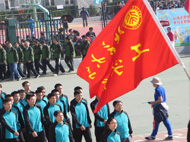主办:能源与资源工程系
报告人:Professor Yu-Shu Wu Department of Petroleum Engineering Colorado School of Mines, Golden CO USA
时间:12月19日(周三)下午15:10
地点:理教417室
主持人:邸元
报告内容摘要:
CO2-EOR has surpassed thermal recovery methods now and becomes #1 approach in EOR operations in the US currently. Typical incremental oil recovery by CO2 IOR/EOR is 5~25 % and about 93% of the CO2-EOR projects in the world have been carried out in the U.S., which contribute to 5% total US oil production. CO2-EOR in the US has steadily increased (~134 projects), but its growth in application has slowed down in the past few years, and this slowdown is primarily due to accessible and affordable CO2 sources. CO2 flooding has been receiving greater attentions due to its effectiveness and capability to increase oil recovery rate from tight oil or low-permeability reservoirs. The US experiences in developing tight oil reservoirs in the past decade has shown that gas injection, such as CO2 or natural gas flooding or huff-n-puff, is the only approach that works for enhancing oil recovery from low-permeability unconventional tight-oil reservoirs. Considering the large reserves in unconventional reservoirs as well as 60-70% remaining oil in place in conventional petroleum reservoirs in the world, CO2-EOR will have even greater potential for world-wide application. However, CO2 flow and displacement behavior in reservoirs, in particular, in low-permeability reservoirs, is not still well studied or understood. The recent field observations and laboratory experiments indicate that effects of rock deformation and thermal condition have non-negligible impacts on the production performance of CO2-EOR. On the other hand, there are many approximations or limitations to model CO2-EOR processes under effects of rock compaction as well as under non-isothermal condition with current reservoir simulation techniques. There is no commercial simulator can handle such complicated flow behavior in CO2-EOR processes.
In this talk, we will present a multiphysical compositional CO2-EOR model, coupled with geomechanics and heat flow, which is a work-in-progress with capabilities to describe complex compositional flow behavior in multiphase multi-component, nonisothermal reservoirs. In this model, the fully coupled fluid and heat flow-geomechanics model is developed from the linear elastic theory for the poro-elastic system. The rock compaction is then correlated with stress-and temperature dependent rock properties through the flow-stress coupling process. We will present several simulation examples for insight of CO2-EOR processes.
报告人简介:
Yu-Shu Wu is a professor in petroleum reservoir engineering, Energi Simulation (Formerly, Foundation CMG) Reservoir Modeling Chair, and director of Energy Modeling Group (EMG) research center in the Petroleum Engineering Department at the Colorado School of Mines (CSM), USA. He is a fellow of the Geological Society of America (GSA). He held MS and PhD degrees from University of California at Berkeley, and B.S. (Eqv.)/MS degrees from China University. He has been a Guest Scientist at the Lawrence Berkeley National Laboratory (LBNL), Berkeley, CA, since 2008, participating in collaborated research projects on development on unconventional natural gas resources, nuclear waste disposal, CO2 sequestration, enhanced geothermal systems (EGS), and cryogenic fracturing technology. In addition, he is currently holding a jointed appointment as a Scientist IV at the National Center for Mechanical and Thermal Science and Engineering of the National Renewable Research Laboratory (NREL), CO.
At CSM, he teaches and carries out research in reservoir engineering, multiphase fluid and heat flow, geomechanics, unconventional oil and gas reservoir dynamics, CO2 EOR and geosequestration, geothermal engineering, and numerical reservoir simulation. He leads the EMG in its research effort in (1) flow and simulation in conventional and unconventional oil and gas reservoirs; (2) coupled processes of multiphase fluid and heat flow, geomechanics, and chemical reaction in porous and fractured media; (3) CO2 EOR and sequestration application; (4) improved formation stimulation/cryogenic fracturing technologies; and (5) hydraulic fracturing modeling. Previously, he was a staff scientist with the Earth Sciences Division of Lawrence Berkeley National Laboratory for 14 years (1995–2008). During his career, he has authored or coauthored 130 peer-reviewed journal papers, 2 books, and 18 peer-reviewed chapters as well as 68 SPE papers.
欢迎广大老师和同学们参加!









